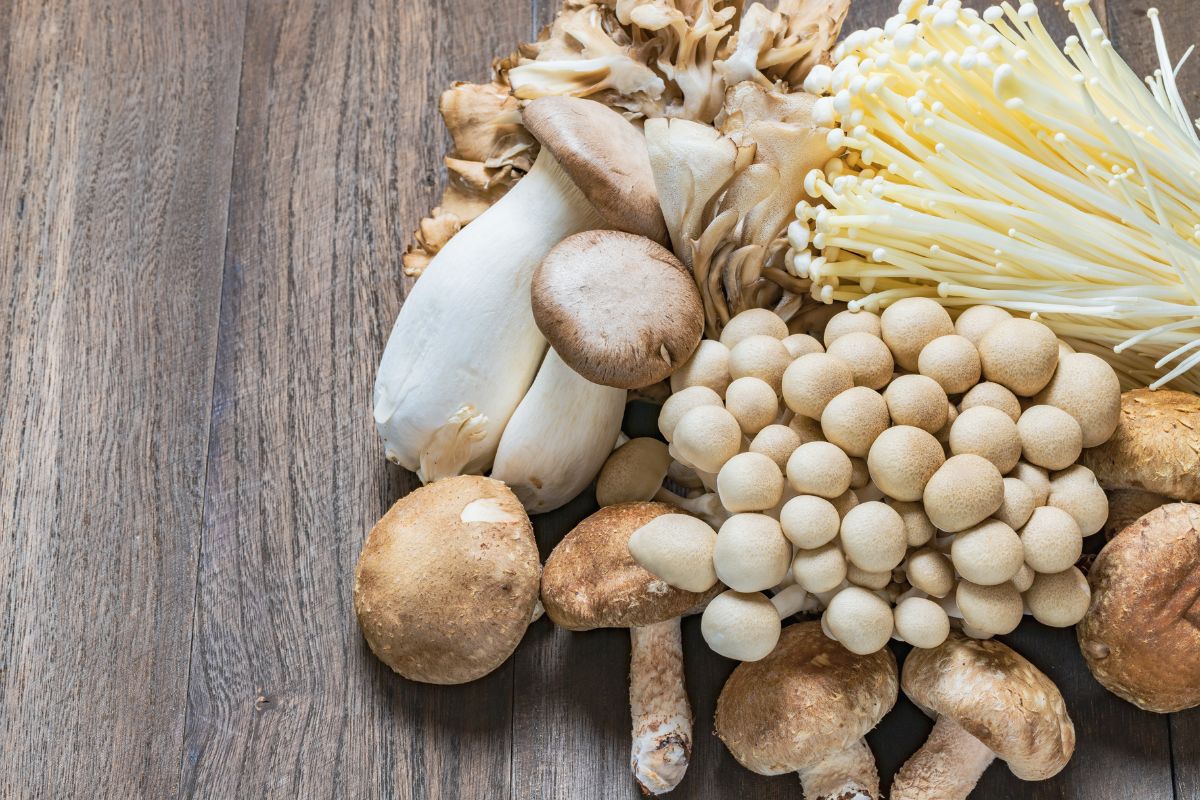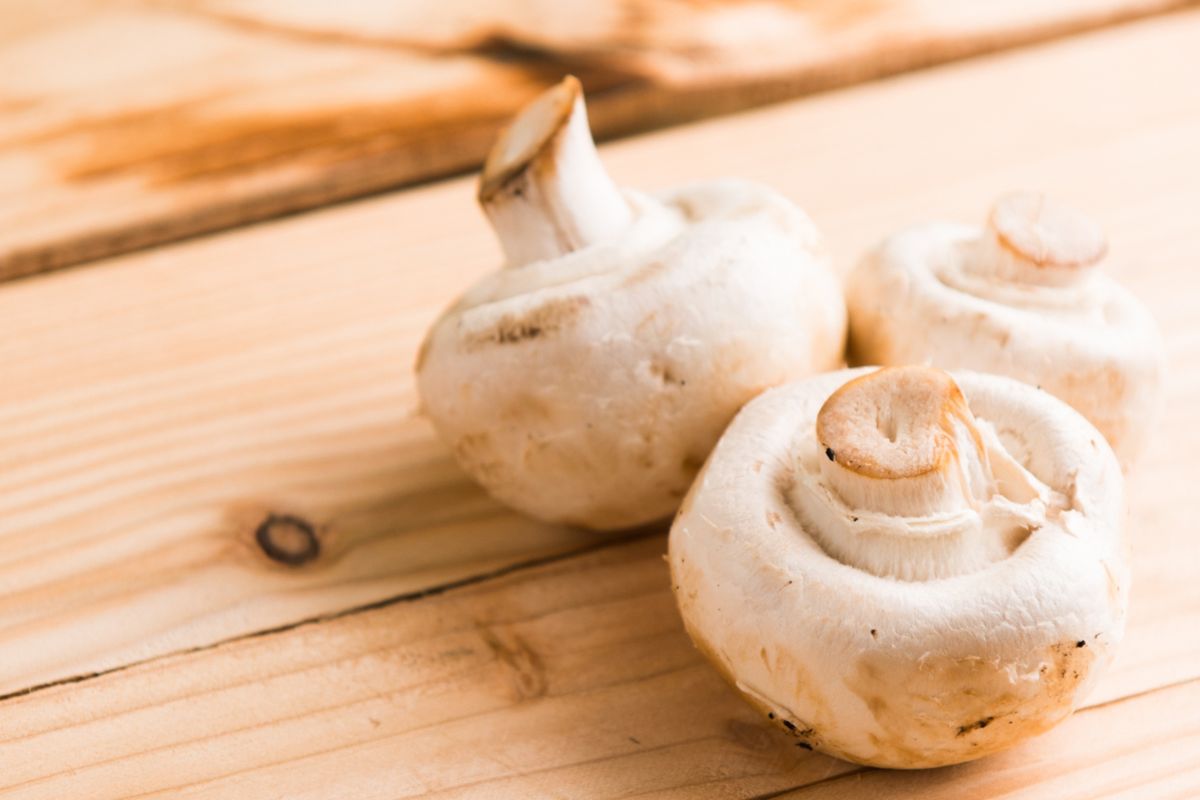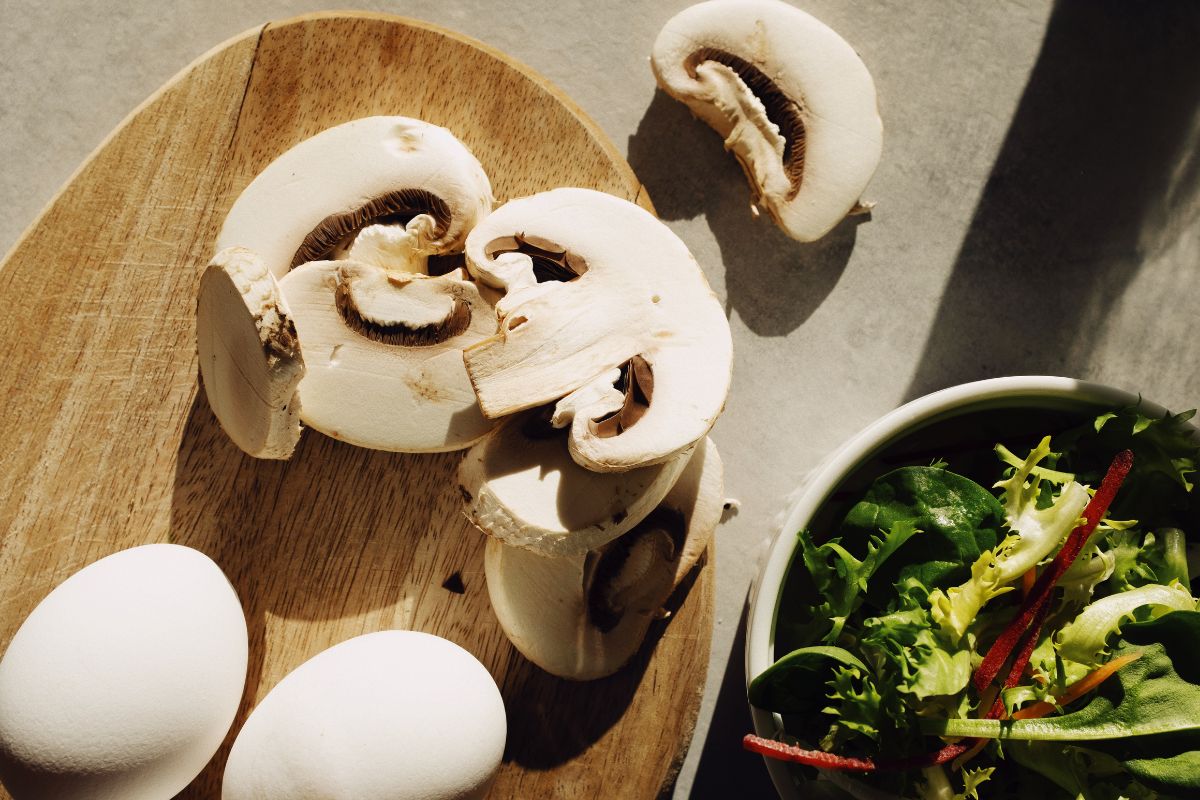What are Mushrooms?
Mushrooms are fungi, organisms that belong to their distinct kingdom separate from plants, animals, and bacteria. So, how long do mushrooms last in the fridge? That depends on how you store them, usually five to seven days.
Mushrooms come in various shapes, sizes, and colors. Some species of mushrooms are edible, while others are toxic or even deadly if consumed. Let’s explore more about keeping your mushroom fresh in a fridge.

Can Mushrooms be Kept in a Fridge?
Yes, you can keep mushrooms in a fridge. In fact, refrigeration is a common method used to prolong the shelf life of mushrooms and keep them fresh for longer. To properly store mushrooms in the fridge, consider the following:
Prepare Your Mushrooms
Before storing mushrooms in the fridge, it’s advisable to gently brush off any debris or dirt using a soft brush or cloth. Avoid rinsing them with water unless necessary, as excess moisture can promote spoilage.
Optimize the Storage Conditions
To maintain the quality of mushrooms, storing them in the refrigerator’s crisper drawer or a section with higher humidity is ideal. The cool temperature and controlled humidity help slow down the growth of bacteria and mold.
Avoid Overcrowding
Allow some space between the mushrooms in the storage container. Overcrowding can lead to moisture buildup and increase the risk of spoilage. If you have a large number of mushrooms, it’s better to store them in multiple containers or use perforated bags to allow for proper air circulation.
Storing cooked Mushrooms
If you have leftover cooked mushrooms, store them in airtight containers in the fridge. However, cooked mushrooms generally have a shorter shelf life than fresh ones, so it’s best to consume them within a few days.
Freezing Mushrooms
If you have an abundance of mushrooms and want to extend their storage life further, you can consider freezing them. To freeze mushrooms, it’s advisable to blanch them briefly in boiling water, then cool and drain them thoroughly before transferring them to airtight freezer bags or containers.
You can store frozen mushrooms for several months, but their texture may change slightly upon thawing.
Remember to always use your best judgment when assessing the freshness of mushrooms. If they appear slimy, have an off-putting smell, or show signs of mold, it’s safer to discard them rather than consume them.
How Long Do Mushrooms Last in the Fridge?
Mushrooms have an average shelf life of five to seven days when stored in the refrigerator. However, several factors can influence how long they remain fresh and usable.
Mushroom Type
The size and variety of mushrooms can affect their lifespan. Larger mushrooms, such as portobello and cremini, tend to last longer than smaller ones, like white button mushrooms, which are more prone to spoilage.
Form
Whole mushrooms generally have a longer shelf life compared to sliced mushrooms. Slicing exposes more surface area, making them more susceptible to moisture loss and spoilage.
Storage
Proper storage is crucial for extending the lifespan of mushrooms. Unlike plastic bags that trap moisture, mushrooms prefer breathable storage. Storing them in paper bags allows for better air circulation and helps maintain their freshness for longer.
Different types of mushrooms, such as shiitake, portobello, and cremini, have varying shelf lives depending on how you prepare them. Here is a breakdown of their storage durations:
Whole Mushrooms
Whole mushrooms can last in the refrigerator for up to two weeks when purchased from the grocery store. It is advisable to consume them within seven to ten days of purchase.
Sliced Mushrooms
Pre-sliced mushrooms have a shorter shelf life; consuming them within a week is best. However, some batches may spoil within five days, so it’s best to check their freshness before use.
Cooked Mushrooms
How long do sauteed mushrooms last in the fridge? Sautéed mushrooms have a slightly longer shelf life compared to raw sliced mushrooms. Cooked mushrooms can last seven to ten days when stored in the fridge. It’s important to note that combining them with quickly spoiling ingredients might accelerate their expiration.
Marinated Mushrooms
Marinated mushrooms, soaked in olive oil with lemon juice and spices, can last for around ten to fourteen days when stored in a sealed glass jar in the refrigerator.
Dried Mushrooms
Properly stored dried mushrooms can last up to three years. It is recommendable to keep them at room temperature in a dry, cool place like the countertop or pantry rather than in the fridge.
Frozen Mushrooms
While you can freeze raw mushrooms, they may lose their texture and become mushy when thawed. It is best to cook, blanch, sauté, poach, or steam the mushrooms before freezing to preserve their quality.
Afterward, freeze them individually on a parchment paper-lined baking sheet until solid. Then transfer them to an airtight, vacuum-sealed plastic bag to prevent freezer burn.
Following these guidelines, you can maximize and enjoy your mushrooms within their optimal freshness window.
How to Store Mushrooms Properly
How long do cooked mushrooms last in the fridge? Well, that really depends on how you store them. Here is what you need to do to keep mushrooms in the fridge properly:
Choose fresh mushrooms: Select mushrooms that are firm, dry, and have an intact appearance. Avoid mushrooms that are slimy, bruised, or have a strong odor.
Store in a breathable container: Place the mushrooms in a paper bag or a breathable container, or wrap them loosely in a paper towel. Avoid plastic bags or airtight containers, as they trap moisture and promote decay.
Maintain proper humidity: Mushrooms prefer a slightly humid environment. You can place a damp paper towel or a clean cloth inside the container to maintain the appropriate humidity level. However, ensure the mushrooms are not in direct contact with the wet towel or cloth.
Store in the refrigerator: Put the container with the mushrooms in the fridge. The ideal temperature range for storing mushrooms is between 32° Fahrenheit (0° Celsius) and 41° Fahrenheit (5°Celsius).
Use them within a few days: While refrigeration can help extend the shelf life of mushrooms, they are still perishable and will eventually start to deteriorate. Using them within a few days is best for optimal freshness and flavor.
Remember that different types of mushrooms may have slightly different storage requirements, so it’s a good idea to refer to specific guidelines for your variety. If you notice any signs of spoilage, such as a foul odor, mold, or sliminess, it’s best to discard them.
Properly stored mushrooms can stay fresh in the refrigerator for up to a week, although their quality may gradually decline with time.

How to Tell if Mushrooms Are Bad
You probably may wonder how long raw mushrooms last in the fridge. And how can you tell if your mushrooms are bad? To determine if your mushrooms have gone bad, you can look for several signs of spoilage. Here are some indicators that mushrooms may no longer be suitable for consumption:
Visual appearance: Check for any visible color, texture, or shape changes. Mushrooms that have turned dark, slimy, or have developed mold growth indicate spoilage.
Strange/bad odor: Fresh mushrooms have a mild earthy smell. If you notice a strong, unpleasant odor, it could be a sign of decay or bacterial growth.
Texture: Mushrooms should have a firm and slightly spongy texture. It indicates they have deteriorated if they feel overly soft, slimy, or mushy.
Discoloration: Pay attention to any unusual discoloration or browning on the surface of the mushrooms. While some browning may occur naturally over time, excessive discoloration suggests spoilage.
Wrinkling or shriveling: Bad mushrooms become wrinkled, shriveled, or excessively dried out. They lose their taste since they are no longer fresh and suitable for consumption.
If you observe any of these signs, it is best to take caution and discard the mushrooms. Consuming spoiled mushrooms can lead to foodborne illnesses, as discussed further in this text. It is important to prioritize food safety and only consume mushrooms that are fresh, properly stored, and free from signs of spoilage.
Do Mushrooms Need to be Refrigerated
While refrigeration is not strictly necessary for all mushrooms, storing them in the refrigerator is generally recommended to help maintain their freshness and extend their shelf life.
Mushrooms are perishable and can spoil relatively quickly at room temperature. Refrigeration helps slow down the growth of bacteria, molds, and other microorganisms that can cause mushrooms to deteriorate. Here are a few reasons why refrigeration is beneficial for mushrooms:
Extend their Shelf Life
Refrigeration can significantly prolong the freshness of mushrooms. The cool temperature helps slow down the enzymatic activity that leads to decay, allowing mushrooms to last longer.
Moisture Control
Mushrooms have a high water content, and refrigeration helps maintain their moisture levels. Storing them in a cool environment with controlled humidity can help prevent them from drying out and shrinking.
Preventing Mold Growth
Refrigeration inhibits the growth of mold spores, which are naturally present in mushrooms and can increase rapidly at room temperature. Keeping mushrooms in the fridge reduces the risk of mold development.
If you cannot refrigerate mushrooms immediately, it’s advisable to store them in a cool, dry place and use them as soon as possible to prevent them from going off. However, refrigeration is the preferred method for longer-term storage to maintain their freshness.
What Happens if You Eat Bad Mushrooms?
Do mushrooms go bad? Yes! Eating bad or spoiled mushrooms can have adverse effects on your health. Consuming mushrooms that have gone bad or contaminated with harmful bacteria, molds, or toxins can lead to foodborne illnesses and digestive issues. Here are some potential consequences of consuming bad mushrooms:
Gastrointestinal distress: Eating spoiled mushrooms can cause gastrointestinal symptoms such as vomiting, nausea, diarrhea, abdominal cramps, and stomach pain. These symptoms may vary in severity depending on the extent of contamination and the individual’s sensitivity.
Food poisoning: Some species of mushrooms contain toxins that are heat-stable and not destroyed by cooking. Ingesting these toxic mushrooms can result in food poisoning. Symptoms may include severe vomiting, diarrhea, dehydration, dizziness, and in extreme cases, organ damage.
Allergic reactions: Certain individuals may be allergic to specific types of mushrooms or may develop allergies due to molds or fungi on spoiled mushrooms. Allergic reactions can be mild symptoms such as itching, rashes, or hives to severe reactions that require immediate medical attention.
Toxicity: Some wild mushrooms contain toxins that are harmful to humans. Ingesting toxic mushrooms, especially those that resemble edible varieties, can lead to poisoning. Symptoms can vary depending on the toxin but may include organ failure, hallucinations, delirium, seizures, or even death in severe cases.
It is crucial to exercise caution and ensure that mushrooms are fresh, properly stored, and correctly identified before consuming them. If you experience any adverse symptoms after eating mushrooms, especially if you suspect they may have been spoiled or toxic, seek medical assistance immediately.
To mitigate the risk of consuming bad mushrooms, it is advisable to purchase them from reputable sources, store them properly in the refrigerator, and if foraging for wild mushrooms, do so with expert guidance and thorough knowledge of mushroom identification to avoid potential dangers.
Our Mushroom Storing Tips
Finding the best way to store mushrooms is essential to enjoy this food longer. Below are some tips for storing mushrooms to help maintain their freshness and quality:
Refrigerate promptly: Refrigerate mushrooms as soon as possible after purchasing or harvesting them. The refrigerator’s cool temperature helps slow spoilage and extends its shelf life.
Use breathable storage: Place mushrooms in a paper bag or container or wrap them loosely in a paper towel. Avoid plastic bags or airtight containers, as they trap moisture and promote decay. The breathable material allows for better air circulation and helps prevent excess moisture buildup.
Store them separately: Keep mushrooms separate from strong-smelling foods in the fridge to prevent them from absorbing odors. Storing them in their container or a separate refrigerator section is best.
Avoid washing before storage: Mushrooms have a high water content, and washing them before storage can make them more prone to spoiling. It’s best to clean them just before use rather than washing them in advance.
Check and remove any spoiled mushrooms: Regularly inspect your stored mushrooms for any signs of spoilage. If you notice any discolored or slimy mushrooms or any with a strange odor, remove them immediately to prevent the spread of decay to other mushrooms.
Use within a few days: While refrigeration helps prolong their shelf life, mushrooms are still perishable and best consumed within a few days of storage for optimal freshness and flavor.
By following these tips, you can help ensure your mushrooms stay fresh and maintain their quality for as long as possible. Keep in mind, when in doubt about the freshness or safety of mushrooms, it’s always better to err on the side of caution and discard them.

Key Takeaways
Storing mushrooms in the refrigerator significantly extends their lifespan compared to keeping them on the kitchen counter. On average, you can enjoy your mushrooms for seven to ten days, providing ample time to explore delightful mushroom recipes.
Larger mushrooms generally have a slightly longer shelf life, while sliced and cooked mushrooms tend to have a somewhat shorter one. If you need your mushrooms to last longer, freezing is an option. When frozen, you can preserve your mushrooms for nearly a year.
However, it’s important to note that during freezing, they may experience a slight loss of nutritional value and may not retain their original appearance when thawed.
By refrigerating or freezing your mushrooms, you can make the most of their availability and ensure their quality for an extended period, allowing you to savor their unique flavors and textures in various culinary creations. Read our article and find out How to Make Cream Sauce for Mushroom Ravioli.

Community of passionate writers and content creators who share a love for Italian heritage, culture, travel, food, and the Italian-American community. Our mission is to celebrate Italy’s rich history and traditions and connect with others who share the same passion.


